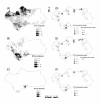Role of wild ruminants in the epidemiology of bluetongue virus serotypes 1, 4 and 8 in Spain
- PMID: 21781340
- PMCID: PMC3156734
- DOI: 10.1186/1297-9716-42-88
Role of wild ruminants in the epidemiology of bluetongue virus serotypes 1, 4 and 8 in Spain
Abstract
Although the importance of wild ruminants as potential reservoirs of bluetongue virus (BTV) has been suggested, the role played by these species in the epidemiology of BT in Europe is still unclear. We carried out a serologic and virologic survey to assess the role of wild ruminants in the transmission and maintenance of BTV in Andalusia (southern Spain) between 2006 and 2010.A total of 473 out of 1339 (35.3%) wild ruminants analyzed showed antibodies against BTV by both ELISA and serum neutralization test (SNT). The presence of neutralizing antibodies to BTV-1 and BTV-4 were detected in the four species analyzed (red deer, roe deer, fallow deer and mouflon), while seropositivity against BTV-8 was found in red deer, fallow deer and mouflon but not in roe deer. Statistically significant differences were found among species, ages and sampling regions. BTV RNA was detected in twenty-one out of 1013 wild ruminants (2.1%) tested. BTV-1 and BTV-4 RNA were confirmed in red deer and mouflon by specific rRT-PCR.BTV-1 and BTV-4 seropositive and RNA positive wild ruminants, including juveniles and sub-adults, were detected years after the last outbreak was reported in livestock. In addition, between the 2008/2009 and the 2010/2011 hunting seasons, the seroprevalence against BTV-1, BTV-4 and BTV-8 increased in the majority of provinces, and these serotypes were detected in many areas where BTV outbreaks were not reported in domestic ruminants. The results indicate that wild ruminants seem to be implicated in the dissemination and persistence of BTV in Spain.
Figures


Similar articles
-
Long-term dynamics of bluetongue virus in wild ruminants: relationship with outbreaks in livestock in Spain, 2006-2011.PLoS One. 2014 Jun 18;9(6):e100027. doi: 10.1371/journal.pone.0100027. eCollection 2014. PLoS One. 2014. PMID: 24940879 Free PMC article.
-
Epidemiological surveillance of bluetongue virus serotypes 1, 4 and 8 in Spanish ibex (Capra pyrenaica hispanica) in southern Spain.Vet Microbiol. 2011 Apr 21;149(1-2):230-5. doi: 10.1016/j.vetmic.2010.10.023. Epub 2010 Nov 4. Vet Microbiol. 2011. PMID: 21111545
-
Evidence for BTV-4 circulation in free-ranging red deer (Cervus elaphus) in Cabañeros National Park, Spain.Vet Microbiol. 2012 Sep 14;159(1-2):40-6. doi: 10.1016/j.vetmic.2012.03.023. Epub 2012 Apr 4. Vet Microbiol. 2012. PMID: 22525011
-
BTV infection in wild ruminants, with emphasis on red deer: a review.Vet Microbiol. 2011 Aug 5;151(3-4):209-19. doi: 10.1016/j.vetmic.2011.02.011. Epub 2011 Feb 23. Vet Microbiol. 2011. PMID: 21411246 Review.
-
The role of wildlife in bluetongue virus maintenance in Europe: lessons learned after the natural infection in Spain.Virus Res. 2014 Mar;182:50-8. doi: 10.1016/j.virusres.2013.12.031. Epub 2014 Jan 3. Virus Res. 2014. PMID: 24394295 Review.
Cited by
-
Bluetongue Virus in the Iberian Lynx (Lynx pardinus), 2010-2022.Emerg Infect Dis. 2024 Oct;30(10):2169-2173. doi: 10.3201/eid3010.240235. Emerg Infect Dis. 2024. PMID: 39320330 Free PMC article.
-
A Multi-Pathogen Screening of Captive Reindeer (Rangifer tarandus) in Germany Based on Serological and Molecular Assays.Front Vet Sci. 2019 Dec 20;6:461. doi: 10.3389/fvets.2019.00461. eCollection 2019. Front Vet Sci. 2019. PMID: 31921918 Free PMC article.
-
Protection of Spanish Ibex (Capra pyrenaica) against Bluetongue virus serotypes 1 and 8 in a subclinical experimental infection.PLoS One. 2012;7(5):e36380. doi: 10.1371/journal.pone.0036380. Epub 2012 May 30. PLoS One. 2012. PMID: 22666321 Free PMC article.
-
Prevalence and predictors of vector-borne pathogens in Dutch roe deer.Parasit Vectors. 2022 Mar 5;15(1):76. doi: 10.1186/s13071-022-05195-w. Parasit Vectors. 2022. PMID: 35248157 Free PMC article.
-
Reintroductions of the Corsican Red Deer (Cervus elaphus corsicanus): Conservation Projects and Sanitary Risk.Animals (Basel). 2022 Apr 11;12(8):980. doi: 10.3390/ani12080980. Animals (Basel). 2022. PMID: 35454227 Free PMC article.
References
-
- Red de Alerta Sanitaria Veterinaria (RASVE), 2009. Ministerio de Medio Ambiente Medio Rural y Marino. http://rasve.mapa.es/Publica/Noticias/Ficheros/Informe%20libre%20serotip... Accessed November 5, 2009.
-
- Red de Alerta Sanitaria Veterinaria (RASVE), 2010. Ministerio de Medio Ambiente Medio Rural y Marino. http://rasve.mapa.es/RASVE_2005/Publica/RASVE_NET_2005/Rasve.Presentacio... Accessed December 18, 2010.
-
- Red de Alerta Sanitaria Veterinaria (RASVE), 2011. Ministerio de Medio Ambiente Medio Rural y Marino. http://rasve.mapa.es/Publica/Programas/NORMATIVA%20Y%20PROGRAMAS/PROGRAM... Accessed April 21, 2011.
-
- De Curtis M, Bartolini C, Canonico C, Duranti A, Leoni F, Mancini P, Moscatelli F, Rocchegiani E, Gavaudan S. Serological monitoring of bluetongue virus in wild ruminants of the Pesaro-Urbino district (Italy) Webzine Sanita Pubblica Veterinaria. 2006;40:3.
-
- Linden A, Mousset B, Gregoire F, Hanrez D, Vandenbussche F, Vandemeulebroucke E, Vanbinst T, Verheyden B, de Clerck K. Bluetongue virus antibodies in wild red deer in southern Belgium. Vet Rec. 2008;162:459. - PubMed
Publication types
MeSH terms
Substances
LinkOut - more resources
Full Text Sources

